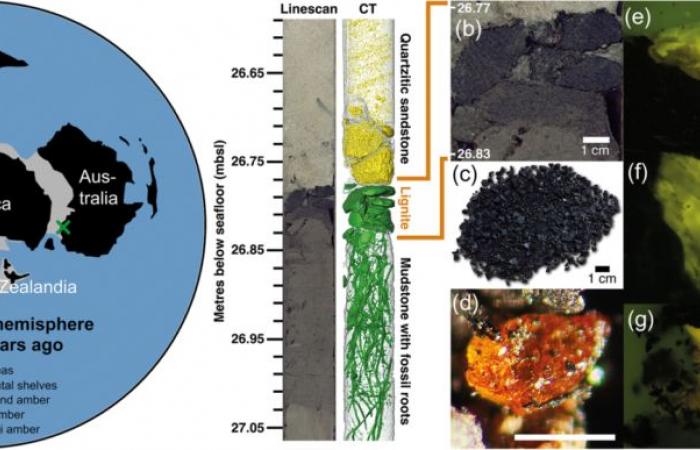Under the extreme cold of Antarctica, an unexpected treasure emerged from the depths: a fragment of amber, a vestige of a tropical forest that has now disappeared.
b) Lignite layer above carbonaceous mudstone at drill site PS104_20 (depth below seafloor indicated).
(c) Crushed and air-dried lignite fragments.
d) Sand-sized amber (photo by V. Schumacher, Alfred Wegener Institute).
e) Photomicrograph of a piece of amber with micro-inclusions (probably remains of bark) at the lignite-amber transition.
f) and g) Photomicrographs of pieces of amber showing signs of pathological resin flow. Scale for d–g: 50 μm.
This exceptional discovery sheds light on a time when the white continent was home to lush biodiversity, far from its current image of desert ice. The amber, found during an expedition in 2017, comes from marine sediments drilled into Pine Island Bay. Dated 90 million years ago, it attests to a much warmer climate during the Upper Cretaceous period.
Plant fossils had previously suggested the presence of ancient forests in Antarctica. But this is the first time that a sample of amber, formed by the fossilization of tree resin, has been discovered on this continent. This material fossil is a precious archive: by trapping organic matterthe resin preserves clues about the vanished ecosystem. Insectsspores or fragments ofbark can reveal the secrets of ancestral life.
The fragments analyzed, although tiny, made it possible to reconstruct a temperate forest environment dominated by conifers. These trees used the resin to protect themselves from attacks, such as parasites or fires. Researchers from the Alfred Wegener Institute are continuing their analyzes to better understand this ecosystem. They hope to find traces of life there or signs of significant events, such as fires.
This discovery reminds us that Antarctica has not always been an inhospitable land. It invites us to re-examine the history of the Earth in a new light. In-depth analysis of amber could provide important insights into past climate and ecosystem adaptations to extreme conditions.
What is fossil amber and why is it so valuable?
Amber is a fossilized resin produced by certain species of trees, mainly conifers. Initially, this resin served as a natural protection against external aggressions, such as parasites or wounds on the bark. Over time, this resin hardened and was buried under layers of sediment, turning into a matter solid and translucent. This material is particularly prized by scientists for its role as a “time capsule”. When it flows, the resin can trap plant fragments, spores, insects and even microorganisms. These inclusions are exceptionally well preserved, providing direct insight into life and ecosystems from distant times, often inaccessible by other means.
The discovery of amber is rare and its conservation depends on specific conditions. A resin must be quickly covered by sediment or water to avoid degradation by ultraviolet rays and oxygen. In Antarctica, the fragments found are of exceptional quality, indicating rapid burial in probably marshy environments. This discovery helps to better understand ancient temperate forests and the ecological interactions that animated them.






